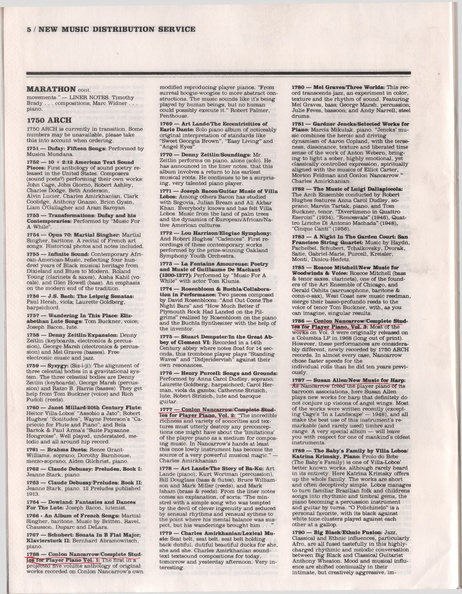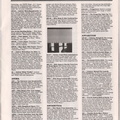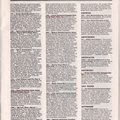6847/18858

MARATHON cont.
movements.” — LINER NOTES. Timothy Brady . . . compositions; Marc Widner . . . piano.
1750 ARCH
1750 ARCH is currently in transition. Some numbers may be unavailable, please take this into account when ordering.
1751 — Dufay: Fifteen Songs: Performed by Musica Mundana.
1752 — 10 + 2:12 American Text Sound Pieces: First anthology of sound poetry released in the United States. Composers (sound poets?) performing their own works: John Cage, John Giorno, Robert Ashley, Charles Dodge, Beth Anderson, Alvin Lucier, Charles Amirkhanian, Clark Coolidge, Anthony Gnazzo, Brion Gysin, Liam OGallagher and Aram Saroyan.
1753 — Transformations: Dufay and his Contemporaries: Performed by “Music For A While”.
1754 — Opus 70: Martial Singher: Martial Singher, baritone. A recital of French art songs. Historical photos and notes included.
1755 — Infinite Sound: Contemporary African- American-Music, reflecting four hundred years of Black musical heritage from Dixieland and Blues to Modern. Roland Young (clarinets & saxes), Aisha Kahil (vocals), and Glen Howell (bass). An emphasis on the modern end of the tradition.
1756 — J.S. Bach: The Leipzig Sonatas: Paul Hersh, viola; Laurette Goldberg, harpsichord.
1757 — Wandering In This Place: Elizabethan Lute Songs: Tom Buckner, voice; Joseph Bacon, lute.
1758 — Denny Zeitlin/Expansion: Denny Zeitlin (keyboards, electronics & percussion), George Marsh (electronics & percussion) and Mel Graves (basses). Free electronic music and jazz.
1759 — Syzygy: (Siz-i-ji): The alignment of three celestial bodies in a gravitational system. The three celestial bodies are Denny Zeitlin (keyboards), George Marsh (percussion) and Ratzo B. Harris (basses). They get help from Tom Buckner (voice) and Rich Fudoli (reeds).
1760 — Janet Millard/20th Century Flute: Heitor Villa-Lobos’ “Assobio a Jato”; Robert Hughes’ “Sonitudes”; Wayne Peterson’s “Ca-priccio for Flute and Piano”; and Bela Bartok & Paul Anna’s “Suite Paysanne Hongroise”. Well played, understated, melodic and all around hip record.
1761 — Brahms Duets: Renee Grant-Williams, soprano; Dorothy Barnhouse, mezzo-soprano; Alden Gilchrist, piano.
1762 — Claude Debussy: Preludes, Book I: Jeanne Stark, piano.
1763 — Claude Debussy/Preludes: Book II: Jeanne Stark, piano. 12 Preludes published 1913.
1764 — Dowland: Fantasies and Dances For The Lute: Joseph Bacon, lutenist.
1766 - An Album of French Songs: Martial Singher, baritone. Music by Britten, Ravel, Chausson, Duparc and DeLara.
1767 — Schubert: Sonata In B Flat Major; Klavierstuck II: Bernhard Abramowitsch, piano.
1768 — Conlon Nancarrow Complete Studies for Player Piano Vol. 1: The first in a projected five volume anthology of original works recorded on Conlon Nancarrow's own modified reproducing player pianos. “From surreal boogie-woogies to more abstract constructions. The music sounds like it’s being played by human beings, but no human could possibly execute it.” Robert Palmer, Penthouse.
1769 — Art Lande/The Eccentricities of Earle Dante: Solo piano album of noticeably original interpretation of standards like “Sweet Georgia Brown”, “Easy Living” and “Angel Eyes”.
1770 — Denny Zeitlin/Soundings: Mr. Zeitlin performs on piano, alone (solo). He has announced in the finer notes, that this album involves a return to his earliest musical roots. He continues to be a surprising, very talented piano player.
1771 — Joseph Bacon/Guitar Music of Villa Lobos: Among others Bacon has studied with Segovia, Julian Bream and Afi Akbar Khan. Everybody knows and has felt Villa Lobos. Music from the land of palm trees and the dynamics of European/African/Native American cultures.
1772 — Lou Harrison/Elegiac Symphony: And Robert Hughes’ “Cadences”. First recordings of these contemporary works performed by the prize-winning Oakland Symphony Youth Orchestra.
1773 — La Fontaine Amoureuse: Poetry and Music of Guillaume De Machaut (1300-1377): Performed by “Music For A While” with actor Tom Klunis.
1774 — Rosenbloom & Buchla/Collaboration in Performance: Two pieces composed by David Rosenbloom: “And Out Come The Night Bars” and “How Much Better if Plymouth Rock Had Landed on the Pilgrims” realized by Rosenbloom on the piano and the Buchla Synthesizer with the help of the inventor.
1775 — Stuart Dempster/In the Great Abbey of Clement VI: Recorded in a 14th Century abbey where notes float for 14 seconds, this trombone player plays “Standing Waves” and “Didjeridervish” against their own resonances.
1776 — Henry Purcell: Songs and Grounds: Performed by Anna Carol Dudley, soprano; Laurette Goldberg, harpsichord; Carol Herman, viola da gamba; Catherine Strizich, lute; Robert Strizich, lute and baroque guitar.
1777 — Conlon Nancarrow/Complete Studies for Player Piano, Vol. 2: “The incredible nchnessand variety of sonorities and textures must utterly destroy any preconceptions one might have about the ‘limitations’ of the player piano as a medium for composing music. In Nancarrow’s hands at least this once lowly instrument has become the source of a very powerful musical magic.” — Charles Amirkhanian
1778 — Art Lande/The Story of Ba-Ku: Art Lande (piano), Kurt Wortman (percussion), Bill Douglass (bass & flutes), Bruce Williamson and Mark Miller (reeds), and Mark Isham (brass & reeds). From the finer notes comes an explanation, of sorts; “The minstrel with a simple song who was tempted by the devil of clever ingenuity and seduced by sensual rhythms and rensual sythms to the point where his mental balance was suspect, but his wanderings brought him ...”
1779 — Charles Amirkhanian/Lexical Music: Seat belt, seat belt, seat belt holding back dutiful, dutiful beautiful ducks for she, she and she. Charles Amirkhanian sound-text textsound compositions for today, tomorrow and yesterday afternoon. Very interesting.
1780 — Mel Graves/Three Worlds: This record transcends jazz, an experiment in color, texture and the rhythm of sound. Featuring Mel Graves, bass; George Marsh, percussion; Julie Feves, bassoon; and Andy Narrell, steel drums.
1781 — Gardner Jencks/Selected Works for Piano: Marcia Mikulak, piano. “Jencks’ music combines the heroic and driving dynamism of Aaron Copland, with the terseness, dissonance, texture and liberated time sense of the work of Anton Webern, bringing to fight a sober, highly emotional, yet classically controlled expression, spiritually aligned with the musics of Elliot Carter, Morton Feldman and Conlon Nancarrow.” Charles Amirkhanian.
1782 — The Music of Luigi Dallapiccola: The Arch Ensemble conducted by Robert Hughes features Anna Carol Dudley, soprano; Marvin Tartak, piano, and Tom Buckner, tenor. “Divertimeno in Quattro Esercizi” (1934), “Rencesvals” (1946), Quattro Liriche Di Antonio Machada” (1948), “Cinque Canti” (1956).
1783 — A Night In The Garden Court: San Francisco String Quartet: Music by Haydn, Pachelbel, Schubert, Tchaikovsky, Dvorak, Satie, Gabriel-Marie, Purcell, Kreisler, Monti, Dinicu-Heifetz.
1785 — Roscoe Mitchell/New Music for Woodwinds & Voice: Roscoe Mitchell (bass & tenor saxes, clarinets), one of the founders of the Art Ensemble of Chicago, and Gerald Oshita (sarrusophone, baritone & conn-o-sax), West Coast new music reedman, merge their basso-profundo reeds to the voice of tenor Tom Buckner, with, as you can imagine, singular results.
1786 -- Conlon Nancarrow/Complete Studies for Player Piano, Vol. 3: Most of the works on Vol. 3 were originally released on a Columbia LP in 1968 (long out of print). However, these performances are considerably different, newly recorded by 1750 ARCH records. In almost every case, Nancarrow chose faster speeds for the individual rolls than he did ten years previously.
1787 — Susan Allen/New Music for Harp: As Nancarrow freed the player piano of its barroom associations, here Susan Allen plays new works for harp that definitely do not conjure up visions of angel wings. Most of the works were written recently (excepting Cage’s ‘In a Landscape’ — 1948), and all make the best use of this instrument’s remarkable (and rarely used) timbre and range. A very special album — will leave you with respect for one of mankind’s oldest instruments.
1789 — The Baby’s Family by Villa Lobos/ Katrina Krimsky, Piano: Prolo do Bebe (The Baby’s Family) is one of Villa-Lobos’ better known works, although rarely heard in its entirety. Here Katrina Krimsky offers up the whole family. The works are short and often deceptively simple. Lobos manages to turn familiar Brazilian folk and childrens songs into rhythmic and timbral gems, the piano becoming a percussion instrument and guitar by turns. “O Polichinelo” is a personal favorite, with its black against white tone clusters played against each other at a gallop.
1790 — Big Black/Ethnic Fusion: Jazz, Classical and Ethnic influences, particularly Afro, are all fused tastefully in this highly-charged rhythmic and melodic conversation between Big Black and Classical Guitarist Anthony Wheaton. Mood and musical influence are shifted continually in their intimate, but creatively aggressive, im-


0 comments